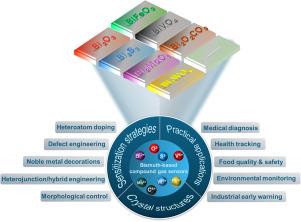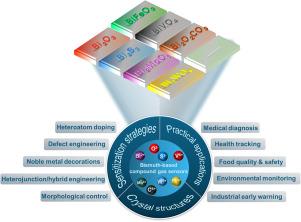铋基化合物平台:从基础到化学电阻气体传感器应用
IF 23.5
1区 化学
Q1 CHEMISTRY, INORGANIC & NUCLEAR
引用次数: 0
摘要
随着物联网技术的快速发展,数字化转型正在深刻推动环境监测、医疗诊断、食品安全等领域快速检测系统的创新。气敏材料是气体传感器的核心单元,金属氧化物基气体传感器具有灵敏度高、成本低、易于集成等特点,已被广泛应用于这些领域。其中,铋基复合材料由于其独特的层状结构(提供丰富的活性位点加速气体扩散和表面反应)、可调的电子性质(如Bi2O3 (Bi3+)和BiVO4 (Bi5+)等多价性质,可以通过掺杂或复合来调节其氧化还原活性,灵活适应不同气体的吸附和反应需要)以及无毒性,成为气体传感器的潜在候选材料。然而,目前的研究仍面临性能不足、传感机制不明确、实际应用瓶颈等挑战,迫切需要充分认识制备-结构-性能-机制的内在相关性。本文综述了各种铋基化合物的晶体结构和电子特性,并阐明了它们与气敏性能的关系。综述了Bi2O3、Bi2S3、Bi2WO6、BiFeO3、Bi2MoO6和bi2o2co3基气体传感器的制备、性能、增强策略、气敏机理和实际应用。在此基础上,提出了基于铋化合物的化学气体传感器面临的挑战,以及对未来重点的见解。本文综述将为铋基化合物气体传感器的发展和研究方向提供新的思路,并进一步促进其在新兴场景中的实际应用。本文章由计算机程序翻译,如有差异,请以英文原文为准。


Bismuth-based compounds platforms: From fundamentals to chemiresistive gas sensor applications
With the rapid evolution of Internet of Things (IoT) technology, digital transformation is deeply driving the innovation of rapid detection systems in environmental monitoring, medical diagnosis, and food safety. Gas-sensitive materials are the core units of gas sensors, and metal oxide-based gas sensors with high sensitivity, low cost, and easy integration have been used in these scenarios. Among them, bismuth-based compound materials are potential candidates for gas sensors because their unique layered structure (providing abundant active sites to accelerate gas diffusion and surface reactions), tunable electronic properties (multivalent properties, such as Bi2O3 (Bi3+) and BiVO4 (Bi5+), which can be doped or compounded to regulate their redox activities, and flexibly adapt to the adsorption and reaction needs of different gases), and non-toxicity. However, the current research still faces challenges such as insufficient performance, unclear sensing mechanism, and practical application bottleneck, and it is urgent to fully understand the intrinsic correlation of preparation-structure-performance-mechanism. In this review, we summarize the crystal structures and electronic characteristics of various bismuth-based compounds and clarify their relationship with gas-sensing properties. The preparation, performance, enhancement strategies, gas sensing mechanism, and practical applications of Bi2O3, Bi2S3, Bi2WO6, BiFeO3, Bi2MoO6, and Bi2O2CO3-based gas sensors are reviewed in detail. On the basis, the challenges faced by the chemical gas sensors based on bismuth compounds are provided, as well as the insights into future focus. This review will provide a new idea for the development and research direction of bismuth-based compound gas sensors, and further promote their practical application in emerging scenarios.
求助全文
通过发布文献求助,成功后即可免费获取论文全文。
去求助
来源期刊

Coordination Chemistry Reviews
化学-无机化学与核化学
CiteScore
34.30
自引率
5.30%
发文量
457
审稿时长
54 days
期刊介绍:
Coordination Chemistry Reviews offers rapid publication of review articles on current and significant topics in coordination chemistry, encompassing organometallic, supramolecular, theoretical, and bioinorganic chemistry. It also covers catalysis, materials chemistry, and metal-organic frameworks from a coordination chemistry perspective. Reviews summarize recent developments or discuss specific techniques, welcoming contributions from both established and emerging researchers.
The journal releases special issues on timely subjects, including those featuring contributions from specific regions or conferences. Occasional full-length book articles are also featured. Additionally, special volumes cover annual reviews of main group chemistry, transition metal group chemistry, and organometallic chemistry. These comprehensive reviews are vital resources for those engaged in coordination chemistry, further establishing Coordination Chemistry Reviews as a hub for insightful surveys in inorganic and physical inorganic chemistry.
 求助内容:
求助内容: 应助结果提醒方式:
应助结果提醒方式:


